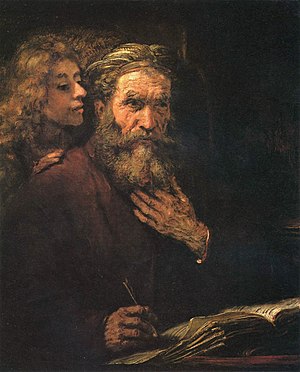Saint Matthew and the Angel (Rembrandt)
| Saint Matthew and the Angel | |
|---|---|
| Saint Matthew and the Angel (Rembrandt) | |
 | |
| Artist | Rembrandt |
| Year | 1661 |
| Medium | oil paint, canvas |
| Dimensions | 96 cm (38 in) × 81 cm (32 in) |
| Location | Room 844 |
| Collection | Department of Paintings of the Louvre |
| Identifiers | Joconde work ID: 000PE008554 RKDimages ID: 58986 |
St. Matthew and the Angel (c. 1661) is an oil on canvas painting by the Dutch landscape painter Rembrandt. It is an example of Dutch Golden Age painting and is now in the collection of the Louvre.
This painting was documented by Hofstede de Groot in 1914, who wrote; "173. ST. MATTHEW THE EVANGELIST. Sm. 136; Bode 270 ; Dut. 102 ; Wb. 276 ; B.-HdG. 521. He sits behind a table with a book open before him, and gazes thoughtfully into the distance. He is turned three-quarters right, and wears a coloured cap. His left hand is at his untrimmed and tangled beard ; his right hand, holding a pen, rests on the book. He wears a loose chestnut-brown robe. An angel with rich fair curls at the back to the left lays his right hand on the evangelist's right shoulder and speaks to him. Half-length, life size. Cf. 172 and 174-5. Signed in the right centre, "Rembrandt f. 1661 "; canvas, 38 inches by 32 inches. Mentioned by Vosmaer, pp. 361, 562 ; by Bode, pp. 523, 594 ; by Dutuit, p. 35 ; by Michel, pp. 463, 562 [361-2, 434]. Etched by Claessens in the Musée Francais ; by Oortman in the Musée Napoléon, in Filhol, viii. 509, and Landon, ii. 57. In the Louvre, Paris, 1907 catalogue, No. 2538."[1]
Rembrandt was influenced in his arrangement with the angel acting as an assistant by an earlier work by Frans Hals:
-
St. Matthew, 1661
References
- ^ Entry 173 for ''St. Matthew the Evangelist in Hofstede de Groot, 1914
- 136. St. Matthew Writing His Gospel in John Smith's catalogue raisonné of 1836
- St. Matthew and the angel in the RKD
- St. Matthew and the angel, in the Rembrandt Research Project


